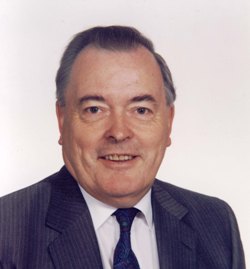George Innes Lumsden 1926-2012
 Dedicated applied geologist who became Director of BGS, and whose advocacy helped save the organisation from closure.
Dedicated applied geologist who became Director of BGS, and whose advocacy helped save the organisation from closure.
Innes Lumsden FRSE, former Director of the British Geological Survey, died in Oxford on Tuesday 4 September aged 86. Brought up in Aberdeenshire, he completed a BSc in Physics at Aberdeen University and added a First Class Honours degree in Geology in 1949. Innes wanted to be involved in applied geology and so he turned down a lectureship at Glasgow University to take up an appointment as a geologist in the Geological Survey of Great Britain, in Edinburgh.
His early tasks were in coalfield geology, including commissioning the Archerbeck Borehole, the deepest cored borehole in the country at the time. Innes dedicated himself to applied geology, establishing a route for the M9 avoiding abandoned oilshale workings, rerouting the A1 to achieve a suitable site for the Torness Power Station while allowing the maximum development of limestone resources in East Lothian and engaging with the feasibility of underground cavern storage.
In 1970 he was appointed District Geologist in charge of South Scotland and became heavily involved in the projects of the Industrial Minerals Assessment Unit and surveys for metallic mineral resources, developing strong links with the Scottish Development Department. On being instructed to resurvey the Southern Uplands he decided that traditional mapping would take too long and achieve little. Instead he started the first multidisciplinary regional geological survey project, a pattern which was soon to be copied in similar projects throughout the UK.
In 1980 he was appointed Assistant Director, Edinburgh and developed the facilities in the Survey’s new Murchison House site. This was terminated abruptly in 1982 when he was appointed Deputy Director at the Survey's new headquarters at Keyworth. His task was to complete the conversion of existing buildings and develop facilities for a modern Survey. He became heavily involved in the day-to-day management of the British Geological Survey (BGS) with reductions in overall funding and difficult relationships with the Natural Environment Research Council (NERC) who were contemplating the future of BGS (without giving BGS the opportunity to state its case).
Lumsden sought the assistance of the Chief Scientist at the Cabinet Office and got an official reprimand from NERC for doing so. The result, however, was the setting up of the Butler Study Group into Geological Surveying and, in 1985 Innes was invited to become Director of BGS! He was responsible for ensuring that the Butler Study Group understood in detail what the function and responsibility of a national geological survey was; but when NERC appointed a Director of Earth Sciences based in Swindon, he decided to step away from the inevitable controversy and retired in August 1987.
Throughout his geological career Innes was an innovator, introducing new methodologies and concepts, new attitudes to geological surveying and new styles of end-product such as Environmental Geology Maps. He believed fundamentally in the need for a national geological survey, as a basic requirement for economic growth and development - a view not always held by the scientific mandarins. But BGS exists still, meeting the needs of the modern world. Innes Lumsden has a place in history as one of those that brought this about.
He is survived by his wife, Sheila and their three children, Graham, Richard and Gillian.
Written by Prof Stuart K Monro OBE, DUniv, FRSE